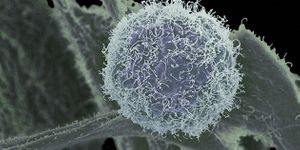Videos
Nice, short video about mitosis
JUN 25, 2014 12:00 AM PDT
Share
New Processes Could Kill Two Birds with One Stone
 CO2, which is generally accepted as being the leading cause of climate change, has been increasing in the atmosphere for many years. But, in April 2014 it reached a level in the northern hemisphere, over 400 parts per million, that the United Nations says has "symbolic and scientific significance." "This should serve as yet another wakeup call about the constantly rising levels of greenhouse gases which are driving climate change," World Meteorological Organization chief Michel Jarraud said in a statement. "Time is running out."
CO2, which is generally accepted as being the leading cause of climate change, has been increasing in the atmosphere for many years. But, in April 2014 it reached a level in the northern hemisphere, over 400 parts per million, that the United Nations says has "symbolic and scientific significance." "This should serve as yet another wakeup call about the constantly rising levels of greenhouse gases which are driving climate change," World Meteorological Organization chief Michel Jarraud said in a statement. "Time is running out."At the same time, the world continues to rely on fossil fuels, which have many obvious disadvantages.
They produce pollutants such as CO2, they aren't renewable, they're expensive, and their supply can be affected by international politics. What if we could reduce our reliance on such fuels, while recycling one of their major pollutants? Two new processes offer hope of this.
Chemists at the U.S. Department of Energy's Brookhaven National Laboratory have found a process which uses ionic liquid as a catalyst to convert carbon dioxide into carbon monoxide, which can then be made into methanol or liquid hydrocarbons which could replace petroleum-based fuels. An added benefit, is that the greenhouse gas, CO2 is being recycled rather than being released into the atmosphere or stored underground (engineered carbon sequestration) to be dealt with in the future. And, if the electricity for this process is generated by solar or wind power, we would have a very clean method for manufacturing fuel.
Other catalysts are available for this reaction, but they require too much energy, are too slow, or produce too many different types of end products to be useful. Brookhaven's approach solves these problems by performing the electrochemical reaction in an ionic liquid rather than in an organic solvent solution. An ionic liquid is similar to table salt, but is in liquid form at room temperature. Such liquids are composed of positive and negative charges which makes them useful as electrolytes. Brookhaven Lab Chemist David Grills, one of the leaders of the research, said, "Our experiment resulted in an improvement in both the energy efficiency and kinetics of the CO2 reduction process for the catalyst we studied, with no loss of product selectivity."
The Brookhaven researchers may also study other ionic liquids and homogeneous catalysts that could convert CO2 to useful products in addition to carbon monoxide. The other leader of the research, Yasuo Matsubara of the Japan Science and Technology Agency, states, "We expect the initial results will open up new possibilities for studying ionic-liquid-enhanced CO2 reduction with a range of homogenous catalysts and different types of ionic liquids."
Another type of CO2 conversion process is under development by Chicago-based LanzaTech, which is using a U.S. Department of Energy grant to study microbial fermentation. It has developed a proprietary microbe that digests carbon monoxide in the waste gas from steel mills, converting it to pure ethanol. LanzaTech's technology can also produce 2, 3 Butanediol, a chemical that can be made into fuels and plastics. Adding to this process' appeal is the fact that LanzaTech's microbe actually thrives in the toxic environment of the waste gas, eliminating the need for the expensive process of cleaning up the gas to enable the microbe's survival.
While promising, the ionic liquid and microbial fermentation processes are not yet close to being ready for commercial use. But they both offer hope that we may be able to solve two of the greatest problems affecting everyone on the planet.
You May Also Like
Loading Comments...








